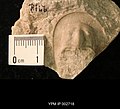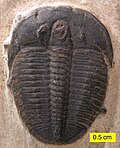List of arthropod orders (section Class †Trilobita)
Arthropods are invertebrate animals having an exoskeleton, a segmented body, and paired jointed appendages. Arthropods form the phylum Arthropoda. They...
17 KB (1,023 words) - 22:29, 29 October 2024
The largest animal currently alive is the blue whale. The maximum recorded weight was 190 tonnes (209 US tons) for a specimen measuring 27.6 metres (91 ft)...
168 KB (16,567 words) - 14:02, 10 November 2024
Ahlberg (2018). "Early post-embryonic development in Ellipsostrenua (Trilobita, Cambrian, Sweden) and the developmental patterns in Ellipsocephaloidea"...
177 KB (9,326 words) - 02:16, 2 November 2024
Zhusilengops is an extinct genus of trilobite in the class Trilobita. "Zhusilengops". GBIF. Retrieved 2020-01-25. v t e...
558 bytes (20 words) - 12:42, 29 April 2021
copepods, malacostracans, branchiopods, hexapods, etc.), and the extinct Trilobita – have heads formed of various combinations of segments, with appendages...
131 KB (12,507 words) - 14:20, 10 November 2024
(1985) placed the order in the Trilobita. Cotton & Braddy (2000) place it in a new "Trilobite clade" containing the Trilobita, recognizing the close affinities...
10 KB (890 words) - 10:11, 18 October 2024
This is a list of fossils found at Maotianshan Shales, whose most famous assemblage of organisms are referred to as the Chengjiang biota. The Maotianshan...
46 KB (599 words) - 14:10, 7 November 2024
veliger Mollusca: freshwater Bivalvia (mussels) glochidium Arthropoda: †Trilobita protaspis (unjointed), meraspis (increasing number of joints, but 1 less...
15 KB (1,378 words) - 09:41, 2 November 2024
Windom shale (section Trilobita)
The Windom shale or Windom member is a member of the Moscow formation in New York. It preserves fossils going back to the Givetian stage of the middle...
11 KB (1,047 words) - 03:01, 13 October 2023
(Vicissicaudata) Diagram of Sinoburius (Xandarellida) Life restoration of Trimerus (Trilobita) After Jiao et al. 2021. Liu, Cong; Fu, Dongjing; Wu, Yu; Zhang, Xingliang...
15 KB (919 words) - 10:17, 3 October 2024
x. S2CID 129912220. "A systematic revision of the family Harpetidae (Trilobita) | Western Australian Museum". museum.wa.gov.au. Retrieved 2024-01-13...
2 KB (157 words) - 23:05, 19 January 2024
Spence Shale (section Trilobita)
The Spence Shale is the middle member of the Langston Formation in southeastern Idaho and northeastern Utah. It is exposed in the Bear River Range, the...
6 KB (425 words) - 08:47, 5 October 2024
The largest prehistoric animals include both vertebrate and invertebrate species. Many of them are described below, along with their typical range of size...
389 KB (40,621 words) - 17:27, 7 November 2024
Wheeler Shale (section Trilobita)
The Wheeler Shale (named by Charles Walcott) is a Cambrian (c. 507 Ma) fossil locality world-famous for prolific agnostid and Elrathia kingii trilobite...
17 KB (1,386 words) - 10:39, 20 March 2024
Pitkin Formation (section Trilobita)
The Pitkin Formation, or Pitkin Limestone, is a fossiliferous geologic formation in northern Arkansas that dates to the Chesterian Series of the late Mississippian...
20 KB (1,286 words) - 19:41, 16 July 2024
Sepkoski, Jack (2002). "A compendium of fossil marine animal genera (Trilobita entry)". Bulletins of American Paleontology. 364: 560. Retrieved 1 December...
2 KB (162 words) - 22:27, 5 April 2024
early Silurian period. The formation has provided the following fossils: Trilobita indet. Carcinosoma sp. Pterygotus sp. Mollusca indet. Arthrophycus sp...
3 KB (129 words) - 01:21, 2 August 2024
(1977). "Evolutionary and Biogeographic Patterns in the Asteropyginae (Trilobita, Devonian) Delo, 1935" (PDF). Bulletin of the American Museum of Natural...
4 KB (444 words) - 19:48, 29 February 2024
Chatterton, Brian D. E. (2020). "Reassessment of the Order Trinucleida (Trilobita)". Journal of Systematic Palaeontology. 18 (13): 1061–1077. Bibcode:2020JSPal...
4 KB (216 words) - 13:05, 14 June 2024
Cryphops (Phacopinae, Trilobita) du Dévonien Supérieur" [Evolution and systematics of the Cryphops group (Phacopinae, Trilobita) from the Late Devonian]...
21 KB (1,783 words) - 14:24, 13 February 2024
Sepkoski, Jack (2002). "A compendium of fossil marine animal genera (Trilobita entry)". Bulletins of American Paleontology. 364: 560. Archived from the...
1 KB (79 words) - 13:26, 26 September 2019
Hamilton Group (section Trilobita)
The Hamilton Group is a Devonian-age geological group which is located in the Appalachian region of the United States. It is present in New York, Pennsylvania...
15 KB (1,281 words) - 15:29, 2 April 2024
Paulus, 1979, = Palaeopoda Packard, 1903] †Nettapezoura †Dicranocaris †Trilobita Walch, 1771 †Megacheira Hou & Bergstrom, 1997 †Strabopida Hou & Bergström...
5 KB (248 words) - 01:59, 30 November 2023
Phytophilaspis Sinoburius Xandarella Zhugeia Nektaspida Conciliterga Haifengella Helmetia Kuamaia Saperion Skioldia Tegopelte Trilobita see Trilobita...
11 KB (1,097 words) - 14:52, 29 November 2023
Mesotardigrada Phylum Arthropoda Class Pycnogonida (?) Clade Arachnomorpha Class †Trilobita Order †Aglaspida Order †Strabopida Class Pycnogonida (?) Order †Cheloniellida...
9 KB (544 words) - 16:58, 19 September 2024
Ptychometopus volborthi Derek J. Siveter (1985). "The type species of Calymene (Trilobita) from the Silurian of Dudley, England" (PDF). Palaeontology. 28 (4): 783–792...
10 KB (703 words) - 22:39, 29 October 2024
Sepkoski, Jack (2002). "A compendium of fossil marine animal genera (Trilobita entry)". Bulletins of American Paleontology. 363: 1–560. Archived from...
1 KB (71 words) - 11:14, 23 September 2019
Sepkoski, Jack (2002). "A compendium of fossil marine animal genera (Trilobita entry)". Bulletins of American Paleontology. 364: 560. Retrieved 2008-01-12...
1 KB (72 words) - 12:24, 12 January 2024




















